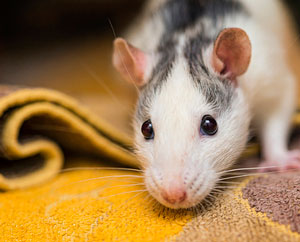Mice Will Shred Fabrics for Nest Material
By Chris Williams on August 15, 2013.

Question
Do mice chew on fabrics? We had an old hamper in the basement with some clothes my kids had outgrown. When I was sorting through them for give-away, I found several pieces with large shredded holes. We have had problems with mice in the basement before, but I didn’t know they chewed on clothes. What else could it be?
Answer
It definitely could be mice that damaged the clothes. If so, they weren’t eating the fabric. That shredding would have been the work of a female mouse looking for nest material. She would choose the softest fabrics she could find and would chew strips for her nest. For a pregnant mouse, finding suitable nest material is of prime importance. In fact, sometimes when we are trapping mice in areas where there is plenty of food available, we will “bait” our traps with cotton balls, yarn, or other nest material instead of food.
Other Fabric Pests
There are, of course, other pests that will damage fabrics but these usually leave smaller holes and sometimes other clues like shed skins or webbing. Clothes moths and carpet beetles are the main fabric pests. Silverfish, crickets, and cockroaches will sometimes chew on fabrics, too. All of these insects, and probably the mice too, are attracted to fabrics that are soiled by food or sweat or other bodily fluids. If you’re storing clothes, make sure you clean them first.
Where Should You Look for a Mouse Nest?
If you look closely in the right places, you might find evidence of a mouse nest, or nests in your basement. Mice will build their nests in a warm place that is close to food and water. They rarely travel more than 30 feet from their nest to their food source which is why most mouse nests are found in kitchens. A good place to start your search is the area of the basement that is directly below the kitchen. Nests are hidden and may not be accessible at all. Nests can be found in hidden areas inside walls and voids (including ceiling voids), under stoves and refrigerators, inside equipment, in boxes, behind kickplates, in clutter and debris piles, inside furniture and drawers, and in wire or pipe chases, to name just a few.
A typical mouse nest is a small mound made up of whatever small, soft items the female can find such as: pillow or furniture stuffing, carpet fibers, feathers, plastic, bits of fabric, shredded paper or paper towels, tissues or toilet paper, dryer lint, cotton balls, bits of string, and grass or leaves if available. She will make as many as 150 foraging trips in a single night to collect the right nest material. A nest may contain bits of hoarded food (like seeds or dry pet food) and there may be black, ¼-inch long mouse droppings nearby.
There’s no reason to live with mice in your basement. Give Colonial a call. One of our mouse experts will look for those mouse nests and can set up a mouse control program that fits your needs. We also do mouse-proofing to seal up the openings that mice use to get into your home in the first place so that you won’t have repeat offenders.
Photo credit: Tambako the Jaguar / Foter / CC BY-ND